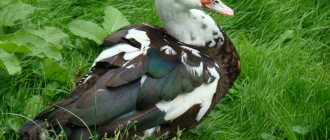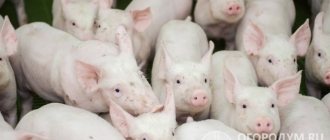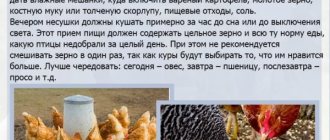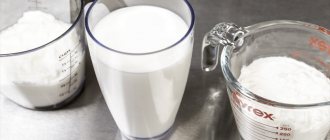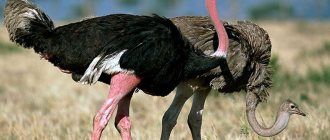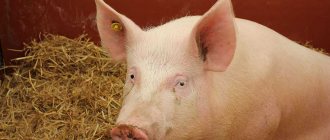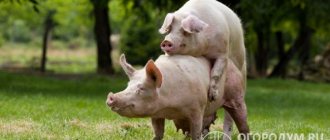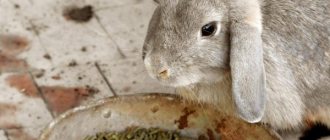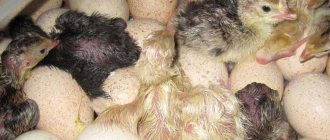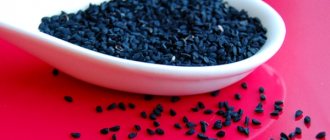We will tell you in this article how long a pig grows before slaughter and how much product can be obtained from it. The question worries many novice livestock breeders, and for good reason. The piglet should not be overfed and slaughter should not be delayed. However, it is also not necessary to kill it too early, since then you do not use the full fattening potential of the animal. In addition, let's touch on the topic of suckling piglets: at what age should they be slaughtered, how to do it correctly so as not to spoil the delicacy.
The younger the animal, the more tender the meat
Suckling pig meat is considered dietary and delicacy. It is not as popular as regular pork, but there are fans who prefer it.
A suckling pig is a baby no more than 8 weeks old that has consumed only pig's milk.
The meat of such piglets is juicy, tender, lacks fat, but contains a lot of vitamins and beneficial microelements. As a rule, these animals are not butchered; the piglet is cooked whole. Only the insides are taken out. At the same time, by-products are often used for stuffing, chopping them and mixing them with spices.
Dairy piglets are slaughtered according to the same principles as adult animals. Read more in the article “Technologies and methods of slaughtering pigs.” There is one difference: usually this is done on a special stool. From one piglet, which weighed up to 20 kg before slaughter, the slaughter yield will be 75%, that is, approximately 15 kg.
Some people believe that slaughtering young animals under 4 months is not profitable. They continue rearing for longer than 8 weeks, but call piglets of this age dairy. It is not right. A real suckling pig should be between 1 and 2 months old. At 4 weeks he weighs 6-9 kg, by eight weeks the weight can reach 20 kg. From a culinary point of view, a minimum weight is considered ideal, otherwise the meat will be tougher than it should be.
Vietnamese pig diet
The Vietnamese breed of pigs has recently become very interesting for breeding. Vietnamese pigs are usually fattened for bacon.
This breed is considered quite unpretentious in food. They are sometimes called vegetarians, which is no coincidence, because the main food of this breed is vegetables and herbs, as well as grain. In order to protect adult pigs from obesity, it is recommended to feed them a maximum of twice a day.
Vietnamese pigs can be fed specially prepared porridges. Add an egg and a tablespoon of fish oil to a 10-liter bucket of porridge. This volume is enough for one feeding of three adults. Summer gives the pig the opportunity to eat pasture.
The Vietnamese breed of pigs is unpretentious in food; the animals willingly eat specially prepared porridge.
How many products can you get?
The weight of the carcass that can be used for food in relation to the weight of the living pig is called slaughter yield. It includes not only meat and lard, but also skin and head. In this case, the weight of the carcass is calculated without blood, bristles, legs and entrails (only the kidneys with kidney fat are left). However, most organs - liver, heart, lungs and even intestines - can be sold.
The percentage of slaughter yield for pigs weighing 100 kg is on average 75%. In this case, the amount of meat, lard and other components is as follows:
- from 63 kg to 72 kg – meat;
- from 14 kg to 25 kg – lard;
- from 500 to 600 g – cartilage, tendons;
- from 12 kg to 13.5 kg – bones.
By-products have two categories of value. The first, more valuable, includes the heart, kidneys, tongue, liver, and diaphragm. The second includes the lungs, stomach, esophagus, legs, larynx, head without tongue and brain, ears, tail, trachea.
The main offal from a pig weighing 100 kg can be obtained approximately as follows: lungs - 800 g, liver - 1.5 kg, heart - 300 g.
Note that the highest slaughter yield is shown by such breeds as Duroc (85-86%), Vietnamese pot-bellied pig (from 85% to 95%), Berkshire and Mirgorod (up to 85%). But other species are not far behind. Pigs generally compare favorably with other farm animals with good slaughter characteristics.
What role does compound feed play?
The stomach of pigs has a single-chamber structure, and therefore, when breeding for meat, special feed is used. When consuming it, the animal must drink a sufficiently large amount of water.
Correct calculation of the daily amount of feed for pigs is very important. After all, knowing how much feed a pig needs per day, it will be possible to ensure the constant growth of the individual. If the calculation is incorrect, disturbances in the functioning of the stomach and intestines of animals may occur.
The composition of the special food is perfectly balanced. The animal will not need additional supplements during the growth process.
Additional feeding
Compound feed "AgroVitEx" is the optimal solution for fattening pigs. However, in some cases, animals need additional feeding to achieve results. It is important to remember some rules:
- Any grain products must be crushed before being placed in the animal trough. In this form they are easier to digest. In addition, the individual eats more food, since whole grains can spill out of the mouth.
- The potatoes must first be washed and boiled.
- Vegetables can be given raw. However, when the percentage of root vegetables in the diet increases, they must first be boiled.
Peas, potatoes, barley, and clover improve the quality of the muscles of piglets and the taste of meat after slaughter. Therefore, whenever possible, these products should be included in the animal’s diet.
Fattening stages
The technology for fattening pigs is not complicated. If you follow its principles, you can ultimately get high-quality lean meat. In this case, fat at the time of slaughter will account for no more than 30% of the total carcass weight.
The feed ration for pigs that are fattened for meat must have good taste that will attract animals. The digestibility coefficient of feed should reach 80%.
Intensive meat feeding consists of two successive stages: preparatory and final.
The preparatory stage begins with the selection of piglets that will be fattened specifically to obtain lean meat, that is, from the age of 2.5 months. It lasts up to 5-5.5 months. At the first stage, the piglet gains 500-600 g per day every day.
In the preparatory period, the basis of the diet is succulent green crops. In summer, pigs are given legumes, melons and green grass. In winter, at this stage, pre-prepared vegetables, grass meal, and silage are given.
The plant component at the preparatory stage will make up a third of the total weight of the diet. The remaining two-thirds of the diet in this period consists of bran, mixed barley and corn, and fishmeal.
The first period of fattening is most advantageous to carry out precisely in the spring-summer period, when succulent and fresh green feed predominates. Thanks to this, it is possible to achieve the greatest animal weight gain with minimal feed costs.
At the first stage, proteins become important, since if you overdo it with carbohydrates, the animals will become fat and lose the ability to build muscle mass. It is also recommended to add feed yeast in the amount of 0.2 kg per day during the preparatory period.
The final stage lasts 2 months. It is more intense and involves a daily increase of up to 800 g.
At the second stage, half of the diet should be food waste, beets, potatoes, and dairy products. The remaining half is occupied by concentrated feeds rich in carbohydrates.
During this period, feeds that deteriorate the quality of meat should be avoided. This is fish and its waste, oats, cake, soybeans, millet.
When sows and boars are slaughtered
On an industrial scale, suckling piglets are rarely sent to slaughter. They are supplied in limited quantities or to order. As a rule, this is a surplus of offspring or culling.
Boars are also rarely slaughtered, for the simple reason that there are not so many of them on the farm. More often this fate befalls hogs (castrated wild boars). Producers are sent to slaughter after several years of work, without significantly delaying the aging process (maximum 5-6 years), otherwise their meat will become unfit for food even after castration.
This operation must be performed no later than two months before slaughter. Otherwise, it is impossible to eat boar meat. The unpleasant smell and taste cannot be removed by any means - neither long-term heat treatment nor soaking in vinegar will help.
As for breeding females, it’s easier with them. However, with age, their meat also loses softness and tenderness, so owners, as a rule, after 8-12 farrows, prefer to slaughter the pig while the products obtained from it can still be sold.
Conditions of detention
Housing conditions are one of the most important factors that can either prolong or shorten the lifespan of pigs. It is the environmental conditions that are the reason that can dramatically influence any natural predisposition to longevity and vice versa. The main requirements that are put forward to pig owners to ensure the longevity of their charges are:
- animals are kept only in warm rooms, protected from drafts, and good ventilation should be created in the barn;
- the optimal temperature regime in the pigsty should be in the range of +18–22 ° C, and the humidity should not exceed 70%;
- pigs should not be kept in crowded conditions; if possible, they should be walked in the fresh air;
- productive piglets need to be protected from noise, strong odors and other natural irritants;
- rooms with animals must be cleaned daily of manure and dirty bedding, and also disinfected at least once a month.
Find out what is considered normal temperature in pigs.
To ensure longevity for pigs, it is strictly forbidden to keep them:
- on open air;
- under conditions of sudden changes in temperature and humidity;
- under the same roof with other pets;
- at a temperature less than +16 °C;
- isolated from sunlight;
- in a common herd with individuals of different ages.
Proper nutrition
A balanced diet will also help ensure longevity for pigs. Despite the fact that these animals are distinguished by their unpretentiousness to feed, the lack of substances important for growth and development in their diet can provoke the appearance of all kinds of pathologies that disrupt the functioning of the entire organism.
To prevent them, the diet of productive individuals should be based on:
- fresh grass from field or meadow herbs;
- hay;
- cereals;
- fruits;
- vegetables (boiled potatoes, beets, carrots).
All kinds of vitamin supplements must be present in the diet of productive pigs. Pregnant and lactating sows are given:
- bone, meat and bone and grass meal;
- fish fat;
- cake of oily crops.
The remaining animals are fed with all kinds of vitamin premixes based on vitamins:
- A - found in pumpkin, carrots, fresh grass, sprouted grains;
- B - bran, cereals and root vegetables are rich in the compound;
- D - produced in the body independently, under the influence of solar radiation;
- E - concentrated in barley, wheat, grass flour.
Important! Salt, spices, sugar, fatty and smoked foods are contraindicated for domestic pigs, regardless of breed, as they cause digestive disorders and metabolic disorders. In addition, pigs are also prohibited from specific feed for other types of animals.
Diseases
Diseases in productive piglets are quite common. In addition to colds and other minor ailments, they can suffer from severe pathologies that cause serious disorders. This contributes to general exhaustion of the body and deterioration of metabolic processes, and in some cases can cause irreversible changes in organs and tissues.
The most dangerous among them are:
- Rickets - causes all kinds of pathologies of the musculoskeletal system, worsening the functioning of the respiratory, cardiovascular and other systems. This leads to general exhaustion, anemia and death.
- Anemia is a pathology of the circulatory system, accompanied by a decrease in the number of red blood cells in the blood mass. It leads to oxygen starvation of the entire body, as well as suppression of the immune system.
- Aueszky's disease is a disorder of nervous activity that causes fever, convulsions, and severe itching of the skin. The disease causes general exhaustion of the body and further death of sick individuals.
Basic rules for preventing diseases in pigs:
- animals are provided with high-quality living conditions, including food;
- The diet of pigs must necessarily contain vitamins and minerals; if they are deficient, pigs are fed with specialized supplements;
- the barn with pigs must be periodically cleaned of manure and disinfected;
- to avoid infectious diseases, animals are vaccinated;
- new individuals must be quarantined for at least 14 days.
Important! The vaccination schedule must be strictly followed, otherwise the effectiveness of the procedure decreases sharply or vaccination becomes impractical.
Other factors
In addition to the above factors, the longevity of piglets also depends on:
- number of gestations (number of pregnancies in sows);
- natural immunity of each individual;
- resistance to ecto- and endoparasites;
- animal size (small pigs always live shorter);
- the presence of seminal glands (in males) - castrated individuals live much longer;
- feed quality;
- ecological situation of the habitat region.
Is it profitable to keep pigs?
Pig farming is a rather expensive branch of agriculture. When deciding to breed pigs, you need to know:
- what direction to choose in pig farming;
- How long does a pig grow before slaughter?
- how much does a pig eat?
- which pigs are better for fattening;
- how to breed piglets, etc.
An important point is the living conditions of the piglets. Therefore, before buying a pig, you need to decide on the place where it will be kept.
Reduces the cost of raising pigs:
- The opportunity to keep a purebred sow that will bear offspring on the farm and the issue of purchasing piglets for fattening will be resolved on its own;
- Availability of feed stock with calculation of feed consumption per pig;
- Sanitary conditions for keeping pigs, preventing their diseases and deaths.
Additional feeding
Compound feed is a balanced diet for animals, but sometimes when fattening pigs need additional food.
There are some features of feeding pigs.
- Before feeding grain to an animal, it is important to grind it well. This way the grain will be better absorbed in the stomach. And it will be more convenient for the pig to feast on it in this form: in its uncrushed form, the grains will fall out of its mouth.
- Before feeding potatoes, they are thoroughly washed to remove any adhering soil and boiled. Boiled potatoes promote better digestibility.
- Vegetables such as carrots, beets, radishes, turnips, which are a source of vitamins for the animal, can be given raw. And if root vegetables are supposed to be the main food for a pig, then they need to be boiled.
In addition to feed, it is recommended to feed pigs potatoes and other vegetables.
How to sell piglets on the market
If a private farm contains one or more purebred sows, there is a need to sell piglets on the market. Receiving indirect income from the sale of young animals is quite justified. The farm only has the required number of heads for fattening.
How to sell piglets quickly?
- Find out in advance how much a live piglet costs for 1 month at market prices; up to a month, piglets are still weak and require maternal feeding;
- Take piglets to fairs after making sure they are healthy; It is advisable that the piglets already eat on their own;
- Use the services of online stores to sell more heads at a good price; Online sales involve buyers coming to your farm or delivering live goods to the customer with an additional payment as agreed.
The income of a pig farm from the sale of piglets can be invested in the purchase of feed for raising pigs for slaughter.
Feeding mode
Depending on the age of the individual, the frequency of meals can be three times a day (for the dairy period) or two times a day (for young and mature individuals). To gain weight as quickly as possible, it is recommended for animals to feed them with mixed feed that is balanced in nutritional composition. It is also possible to use food waste, but in this case it will not be possible to quickly fatten the piglet.
Conventionally, there are 2 modes of feeding animals:
- Wet (regular, traditional). In this case, mash is mainly used - a mixture of vegetables, food waste, grain crops, trauma and hay.
- Dry. The emphasis is on mixed feed, various mixtures of grain crops. With this type of feeding, one important condition applies - you need to give the animals enough water. Otherwise, constipation develops and the rate of weight gain decreases.
Today, in 80-85% of cases, pig farmers choose the second feeding mode. It does not require constant cooking of mash. The main thing is to first calculate the amount of feed required (according to the information given above), mix it with additional components and pour it into the trough.
In addition, dry feeding minimizes odor from the animal and speeds up the conversion of manure into fertilizer. This diet ensures rapid weight gain for pigs, which makes it more popular among pig farmers.
How to raise a piglet to 120 kg in 6 months
Raising a piglet at home in six months so that it gains a weight of 120 kilograms or so is a feasible task, of course, provided good care and nutrition are provided.
11:03
Weight at 6 months / How much food eaten
Initially, you should be responsible when purchasing piglets. They must be healthy and not lag behind in development.
The best option are piglets from one and a half to two months. It should be noted that pigs are herd animals, so you should buy 2 or more piglets, otherwise the piglet will not have an appetite).
Piglets are divided into three fattening periods, the first is dairy, when the formation of organs and muscles occurs, the second is rearing, in which they grow intensively, and fattening is the weight gain itself.
During the milking period, the daily diet of piglets consists of milk, for example cow or goat milk at the rate of about 3 liters of milk per animal and one liter of porridge from any small cereals.
Feeding should be carried out at least 4-5 times a day.
From three months of age. piglets can already dilute the milk by half with water, the frequency of feeding is reduced to three times a day. During this period, it is necessary to add fresh chopped grass, bran, and minerals to food. Gradually, milk in the diet is replaced with whey or skimmed milk, and the food itself consists of crushed grass and bran. During this period, the piglets should have sufficient space to walk.
From the fifth month of age, the fattening period begins, i.e., intensive weight gain occurs and in addition to increasing the amount of feed, the piglets must be limited in their movements, for this they are placed in small pens.
During the fattening period, food should be the most high-calorie, representing boiled root vegetables, food waste from the kitchen, feed mixtures, cake, crushed grain. Feeding itself is carried out twice a day.
At this stage, you should decide what will be the main result of the final result. After all, there are differences between fattening a pig for meat or when fat is needed more.
To obtain more meat quality, the food should include more greens up to 5 kg per day and mixed feed or crushed food.
Over time, this norm gradually increases and potatoes, beets, pumpkin, etc. are added. Do not forget about salt and chalk, approximately 5-35 grams each.
If you need to get more fat, you should use more feed rich in carbohydrates and millet and barley to improve the quality of fat.
During the fattening period, daily weight gain, with good nutrition, can be up to 1 kilogram.
For example. in summer this is achieved with a diet consisting of 4 kg of greens, 3.5 kg of pumpkin. concentrate 3.3 kg and 50 grams of salt.
